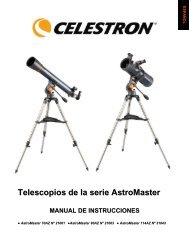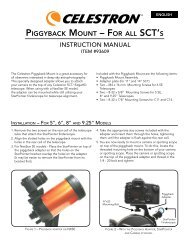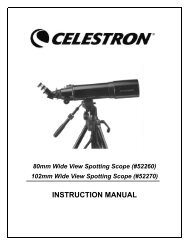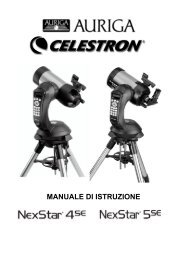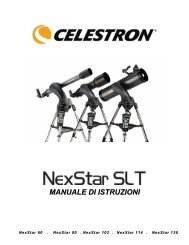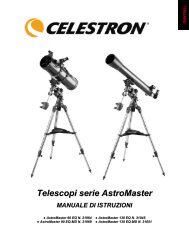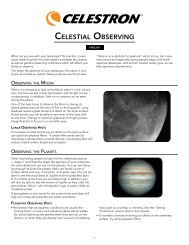2009-10 Celestron Telescope Catalog
2009-10 Celestron Telescope Catalog
2009-10 Celestron Telescope Catalog
You also want an ePaper? Increase the reach of your titles
YUMPU automatically turns print PDFs into web optimized ePapers that Google loves.
Mount and <strong>Telescope</strong> Descriptions<br />
The mounT and Tripod<br />
To a large extent, a telescope is only as good as its tripod and mount. A telescope magnifies everything,<br />
including vibration. That’s why many telescopes with good optics are rendered useless when supplied on an<br />
inexpensively made mount. Since you’ll be using a mount’s controls to track the slow and steady apparent<br />
movement of the stars, a suitable mount’s adjustments should be smooth, yet precise.<br />
altazImuth vs. equatorIal<br />
There are two basic types of mounts: Altazimuth (Alt-Azimuth) and Equatorial. Altazimuth mounts are<br />
the simplest type of mount with two motions: altitude (up and down/vertical) and azimuth (side-to-side/<br />
horizontal). Good Altazimuth mounts will have slow motion cable controls to make precise adjustments,<br />
which aid in keeping tracking motion smooth.<br />
These types of mounts are good for terrestrial observing and for scanning the sky at lower power but are<br />
not advised for deep sky photography.<br />
Both Altazimuth and Equatorial mounts can track the stars sufficiently for visual use, however, only<br />
equatorials can be used for long exposure astrophotography. Since Altazimuth mounts are not aligned<br />
with the Earth’s axis, they must use both axes to track an object. With Altazimuth mounts you will be able<br />
to accurately track an object centered in the field of view, however, over time all the other stars in the<br />
field will appear to rotate around the center of the field. This is hardly noticeable in an eyepiece, but is<br />
obvious on film.<br />
altazImuth advantages<br />
n Easy to set-up and use<br />
n Least expensive type of mount<br />
n Ideal for terrestrial observing<br />
altazImuth dIsadvantages<br />
n Cannot be used for long exposure photography<br />
n Non-computerized models cannot track stars and planets<br />
On an Equatorial mounting, the two axes are perpendicular<br />
to each other as they are on an Altazimuth mount. But on an<br />
Equatorial mounting, the left-to-right axis has been tilted so<br />
that it is parallel to the Earth’s axis instead of at the horizon.<br />
On an Equatorial mount, only the axis that is parallel to the Earth’s axis needs to be rotated. On an Altazimuth<br />
mount, BOTH axes must be moved.<br />
If you would like to do long exposure photography, the telescope must be mounted on an equatorial mount.<br />
Some <strong>Celestron</strong> telescopes that are on Altazimuth mountings can be tilted up (with the use of an equatorial<br />
wedge) to orient the azimuth axis parallel to the Earth’s axis.<br />
equatorIal advantages<br />
n Best for long exposure photography<br />
n Easy to use visually because only one axis movement compensates for Earth’s rotation<br />
n Setting circles on non-computerized models help locate astronomical objects<br />
equatorIal dIsadvantages<br />
n Set-up is more extensive because of polar alignment<br />
requirements<br />
n Not suitable for terrestrial use<br />
do you wanT a goTo<br />
CompuTerized TelesCope?<br />
Many of <strong>Celestron</strong>’s telescopes are computerized “GoTo” telescopes. GoTo capability is very useful<br />
for the novice who needs assistance in finding objects in the night sky. Since there is a large database<br />
of celestial objects, it is unnecessary to refer to star charts to identify objects. Once the telescope is<br />
properly aligned and an object is selected, the telescope will automatically “go to” the object. GoTo<br />
equipped <strong>Celestron</strong> telescopes include both altazimuth and equatorial models. Even without GoTo, many<br />
<strong>Celestron</strong> equatorial scopes have manual setting circles that allow you to find objects in the sky with the<br />
help of a good star map.<br />
There are a number of factors to consider when selecting a particular telescope. These factors will<br />
usually depend on your individual requirements including cost, portability, versatility, usability and<br />
appearance. You should also consider how you plan to use the instrument both now and in the future.<br />
Most important, consider your budget and portability requirements, and select a telescope with the<br />
largest aperture possible.<br />
Types of TelesCopes<br />
REFRACTOR TELESCOPE<br />
A refractor telescope uses a lens as the primary. The lens at the front of the telescope bends the light<br />
passing through it until it comes to a single point called the “focal plane”.<br />
The long, thin tubes of refractor telescopes look much the same as those Galileo used centuries ago.<br />
High quality optical glass and multi-coatings provide today’s sky watchers views Galileo never dreamed<br />
of. The refractor type of telescope is very popular with individuals who want mechanical simplicity,<br />
rugged reliability and ease of use. Because the focal length is limited by the length of the tube, refractor<br />
telescopes become quite bulky and expensive beyond a four inch aperture. This limits the light gathering<br />
properties of refractor telescopes, but it is an excellent choice for beginners and those who prefer simple<br />
operation and versatility. Refractor telescopes are also a popular choice because of their unobstructed<br />
view, high contrast and good definition.<br />
mount and <strong>Telescope</strong> descriptions 37



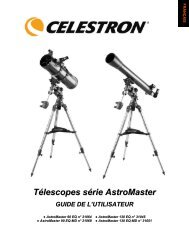

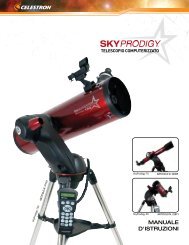
![Guía para realizar un ensablaje rápido [continuación] - Celestron](https://img.yumpu.com/14596837/1/190x245/guia-para-realizar-un-ensablaje-rapido-continuacion-celestron.jpg?quality=85)
